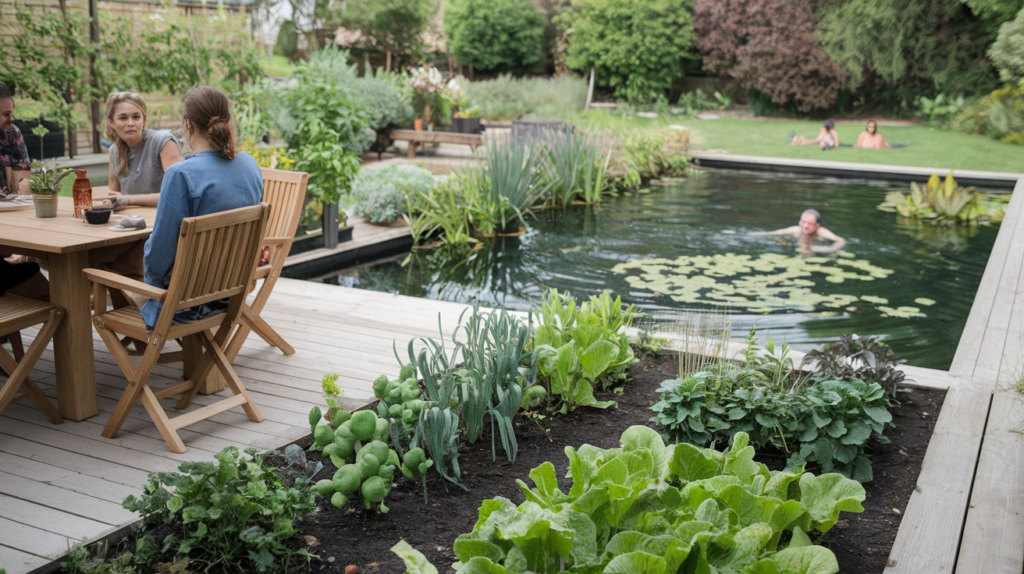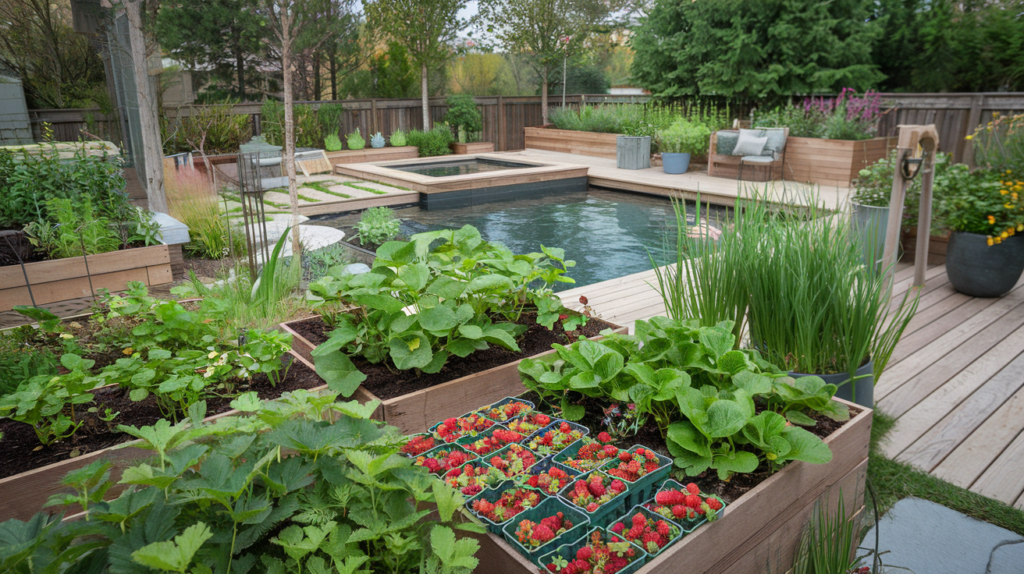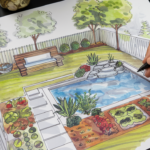MY Tips
Edible Landscaping: A Practical
Guide Using Permaculture Principles
Incorporating edible plants into your landscape is a rewarding way to create a beautiful, functional, and sustainable environment. Edible landscaping, when designed with permaculture principles, goes beyond aesthetics—it turns your garden into a productive ecosystem that nourishes both you and the planet. Here’s how to get started.
1. What Is Edible Landscaping?
Edible landscaping blends traditional ornamental garden design with food-producing plants. Instead of conventional lawns or purely decorative plants, your yard can be transformed into a source of fresh fruits, vegetables, herbs, and even nuts.
Using permaculture principles, edible landscaping not only provides food but also conserves resources, reduces waste, and enhances biodiversity. It’s about designing with nature rather than against it.
2. Start with Observation and Planning
Permaculture Principle: Observe and Interact
- Spend time understanding your site’s unique conditions, such as sunlight, wind patterns, and water flow.
- Identify microclimates—spots that are warmer, cooler, wetter, or drier than others—and match plants to these areas.
- Consider your household’s needs: How much food do you want to grow, and which plants will you use most?
Action Step:
Sketch your space, noting existing structures, trees, and natural features. Highlight areas with optimal sunlight for food production.

3. Design Zones for Efficiency
Permaculture Principle: Zoning
Organise your garden into zones based on how often you’ll interact with different areas:
- Zone 1: Close to the house for herbs, salad greens, and other high-use plants.
- Zone 2: Slightly farther out for fruit trees, perennial vegetables, and shrubs.
- Zone 3: For less intensive crops like nut trees, berry bushes, and compost systems.
Action Step:
Group plants with similar needs together (e.g., water-loving vegetables near rainwater collection areas).
4. Diversify with Polycultures
Permaculture Principle: Use and Value Diversity
Monocultures (single-crop gardens) are prone to pests and diseases. Instead, mix plants that benefit each other. This is called a guild in permaculture:
- Plant nitrogen-fixing species like beans or peas near heavy feeders like tomatoes.
- Pair pest-repellent herbs, such as basil or marigolds, with vegetables.
- Add ground covers like strawberries to suppress weeds and retain soil moisture.
Action Step:
Create a plant guild by combining a fruit tree, nitrogen-fixing shrubs, pollinator plants, and ground covers.

5. Manage Water Wisely
Permaculture Principle: Catch and Store Energy
Efficient water use is crucial for edible landscaping.
- Install rainwater tanks or barrels to collect runoff from your roof.
- Use swales or trenches to direct rainwater into garden beds.
- Mulch heavily to retain soil moisture and reduce evaporation.
Action Step:
Build a simple rain garden or install drip irrigation to ensure consistent watering with minimal waste.
6. Embrace Vertical Gardening
Permaculture Principle: Use Edges and Value the Marginal
Maximise small spaces by growing vertically. Trellises, arbors, and walls can support climbing plants like beans, cucumbers, and passionfruit.
Action Step:
Add trellises to sunny walls or fences to grow vertical crops, saving ground space for other plants.
7. Build Healthy Soil
Permaculture Principle: Produce No Waste
Healthy soil is the foundation of an abundant edible landscape. Compost food scraps and garden waste to create nutrient-rich soil amendments. Incorporate organic matter like aged manure or leaf mulch to improve fertility.
Action Step:
Start a compost bin and regularly add kitchen and garden scraps to build soil health.
8. Plant for Year-Round Harvests
Permaculture Principle: Obtain a Yield
Choose a mix of plants that produce food throughout the year. Include annuals for quick harvests and perennials for long-term production.
Suggestions:
Spring: Strawberries, asparagus, peas.
- Summer: Tomatoes, cucumbers, zucchinis.
- Autumn: Pumpkins, apples, figs.
- Winter: Kale, broccoli, citrus.
Action Step:
Create a planting calendar tailored to your climate.
9. Attract Pollinators and Beneficial Insects
Permaculture Principle: Integrate Rather than Segregate
A thriving edible landscape relies on pollinators like bees and butterflies. Plant native wildflowers, herbs, and flowering vegetables to encourage these helpers.
Action Step:
Add a pollinator patch with nectar-rich flowers near fruit trees or vegetable beds.
10. Reduce Maintenance with Perennials
Permaculture Principle: Use Small and Slow Solutions
Perennials like rhubarb, artichokes, and berry bushes provide food year after year with less effort than annuals. They also help build stable ecosystems.
Action Step:
Include at least 30% perennial plants in your edible landscape for long-term productivity.
11. Practical Example: An Edible Front Yard
Transforming a traditional front lawn into an edible garden is a simple and impactful way to embrace edible landscaping:
- Replace grass with raised vegetable beds and perennial herbs like rosemary and thyme.
- Add a dwarf fruit tree as a focal point.
- Use a mix of pollinator-friendly flowers to create visual appeal and ecological benefits.
Conclusion
Edible landscaping is more than just growing food—it’s about designing a harmonious, sustainable system that supports the environment and enhances your lifestyle. By applying permaculture principles, you can create a productive and resilient garden that works with nature, not against it.
Start small, observe the results, and enjoy the process of transforming your landscape into an edible paradise. Happy gardening!

Our recommendations and information provided in our articles, blog and on this website is intended to be educational and informative only. It is at no time to be relied upon as personal advice for your own situation. While we try our best to ensure that the information is accurate, sometimes it may not be suitable or correct for your particular circumstances or the products or services you may choose to purchase.
Any comments, guidance, or information on this website is our own view and based on our experience and we do not provide any guarantees, warranties relating to any aspect of the information, including but not limited to any reliance on the safety or security of any landscape recommendations, renovations, designs, plant use or any particular installations. We hope you find it helpful but please be aware that it may not be suitable for your situation, location, surroundings or other specific needs. This information is offered in good faith and it is not specific to any one person or any personal circumstance. You should contact us directly so we may review and assess your own situation to be able to provide recommendations specific to your own requirements, particularly if you are in a fire, drought or other sensitive area.
We hope you understand that for this reason, we are not to be held liable for any decisions you make based on any of the information, views, or recommendations on our website and in our blog articles and any consequences, as a result, are your own.
The information shown and posted on this website or expressed by either the moderator is the view of the person(s) posting only and is intended to be examples only and not advice for you personally.
Any decisions or information on this website you decide to use, read or act upon is done at your own risk and you shall indemnify yourlandscapejourney.com, its directors and employees for any and all claims whether resulting directly or indirectly from your actions.




